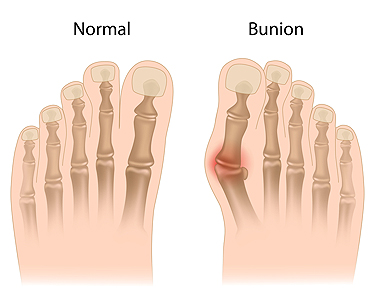Types of Bunions
Monday, 03 August 2020 00:00 A bunion is a bony bump that forms on the joint at the base of the big toe or, occasionally, on the pinky toe. The bunion causes the affected toe to point towards the other toes, instead of pointing straight ahead. Bunions may be painful, making it difficult to walk, stand, wear your typical shoes, or do your usual daily activities. There are two main types of bunions, although many bunions can be a combination of both types. A positional bunion is caused by the joint enlarging as new bone grows. This stretches the outer covering of the joint and pushes the big toe towards the smaller ones, eventually pulling the big toe out of alignment. A structural bunion is caused by the angle between the bone of the big toe and second toe being larger than normal. This can also push the big toe towards the smaller toes. Regardless of the type of bunion you may have, it is recommended that you seek treatment from a podiatrist.
A bunion is a bony bump that forms on the joint at the base of the big toe or, occasionally, on the pinky toe. The bunion causes the affected toe to point towards the other toes, instead of pointing straight ahead. Bunions may be painful, making it difficult to walk, stand, wear your typical shoes, or do your usual daily activities. There are two main types of bunions, although many bunions can be a combination of both types. A positional bunion is caused by the joint enlarging as new bone grows. This stretches the outer covering of the joint and pushes the big toe towards the smaller ones, eventually pulling the big toe out of alignment. A structural bunion is caused by the angle between the bone of the big toe and second toe being larger than normal. This can also push the big toe towards the smaller toes. Regardless of the type of bunion you may have, it is recommended that you seek treatment from a podiatrist.
If you are suffering from bunions, contact Dr. Ronald K. Olm of Grand Traverse Foot & Ankle Center. Our doctor can provide the care you need to keep you pain-free and on your feet.
What Is a Bunion?
A bunion is formed of swollen tissue or an enlargement of boney growth, usually located at the base joint of the toe that connects to the foot. The swelling occurs due to the bones in the big toe shifting inward, which impacts the other toes of the foot. This causes the area around the base of the big toe to become inflamed and painful.
Why Do Bunions Form?
Genetics – Susceptibility to bunions are often hereditary
Stress on the feet – Poorly fitted and uncomfortable footwear that places stress on feet, such as heels, can worsen existing bunions
How Are Bunions Diagnosed?
Doctors often perform two tests – blood tests and x-rays – when trying to diagnose bunions, especially in the early stages of development. Blood tests help determine if the foot pain is being caused by something else, such as arthritis, while x-rays provide a clear picture of your bone structure to your doctor.
How Are Bunions Treated?
- Refrain from wearing heels or similar shoes that cause discomfort
- Select wider shoes that can provide more comfort and reduce pain
- Anti-inflammatory and pain management drugs
- Orthotics or foot inserts
- Surgery
If you have any questions, please feel free to contact one of our offices located in Traverse City and Kalkaska, MI . We offer the newest diagnostic and treatment technologies for all your foot care needs.





